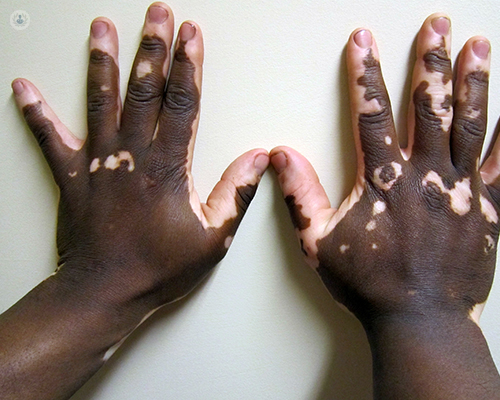

What is vitiligo?
Vitiligo is a condition that consists of a progressive depigmentation of the skin in different areas of the body causing white spots. The depigmented areas of the skin can manifest themselves in different ways – either spread over the body or in specific locations (for example, only on one side of the body). Its appearance can arise at any age.

What are the symptoms of vitiligo?
The main and visible symptoms of vitiligo are white spots on the skin. These are more common in those areas more exposed to the sun such as hands, feet, arms, face or lips. Other areas may include the armpits, groin, eyes, nostrils, navel, genitals and rectal areas. Often people with this condition have grey hair prematurely and those with dark skin may notice a loss of colour inside their mouth.
What causes vitiligo?
This disease is caused by the destruction of certain cells known as melanocytes which are responsible for the creation of melanin, a pigment in the skin. Though the causes are not clear, vitiligo is associated with conditions of an autoimmune origin, such as Addison's disease or diabetes.
Can vitiligo be prevented?
Due to the lack of conclusive studies about the cause of vitiligo, there is no absolute way to prevent this disease. One way to try and prevent vitiligo is to avoid sun exposure, especially at times when the heat intensity is high. Applying sun lotion may help too.
What is the treatment for vitiligo?
Depending on the severity of each case - the number of spots, the rate of spread and the patient's preferences, the treatment will vary. Not all treatments are appropriate for all patients. A large number of treatment options may involve unexpected side effects, or may be prolonged and sometimes, without the desired results being achieved.
There are certain medications that can be applied directly to the skin or taken orally oral, which can be combined with ultraviolet light to remove the white spots. Surgical treatments include skin grafts taken from the patient's own tissue. Tattoos have been used as well, especially for those who have small affected areas. Thirdly, using sun lotions can help, and using makeup or dyes to cover the white spots.
